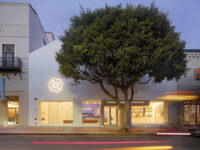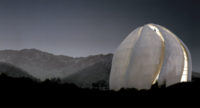Renovation Project's Acoustician: IdibriGarden Grove, California
For years, Philip Johnson's glass-skinned Crystal Cathedral in Garden Grove, California'completed in 1981 for televangelist Robert Schuller and his Reformed Church in America'operated as a broadcasting venue as well as a house of worship. Services were filmed for TV and more than 2,000 congregants sat in rows of padded chairs facing the interior's north side, which featured a pulpit, the Hazel Wright Memorial pipe organ (one of the largest in the world), and space for a choir and other performers.
In 2012, two years after Schuller's church filed for bankruptcy, the Roman Catholic Church bought the cathedral with plans to turn it into the seat of the Diocese of Orange. Now renamed Christ Cathedral, its almost 80,000-square-foot interior is in the midst of an overhaul at thehands of Los Angeles firm Johnson Fain. The renovation will make the space suitable for Catholic services and will also improve interior comfort, including acoustics, says Scott Johnson, firm principal. (Scott and Philip are not related, but early in his career Scott worked on the Crystal Cathedral project as a design associate at Philip's firm, New York'based Johnson Burgee.)
With thousands of single-glazed panels supported by a steel space frame, the iconic building envelope creates a greenhouse-like effect. Excess solar gain is common, and the interior, which has no mechanical air conditioning, is cooled passively via operable panels, resulting in widely fluctuating temperatures, air velocities, and humidity levels. These microconditions affect the way sound travels, leading to big variations in the space's reverberation time, or the number of seconds it takes for a sound to decrease by 60 decibels. The cathedral's asymmetrical floor plan and ceiling heights that range from about 50 feet to 120 feet exacerbate the problem. In addition, the glass skin reflects high-frequency sounds (e.g., bouncing high musical notes into the interior, resulting in a bright and echoey sound) but resonates, or vibrates, at low frequencies, allowing deep notes to escape the envelope. 'Sound quality was unreliable in the old configuration,' says Jeff Miller, senior consultant at Idibri, the renovation project's acoustician. 'Our goal is to narrow the range of reverberation times so that people will understand and enjoy spoken liturgy, music, and singing.'
The project team, seeking a streamlined solution, has conceived a system of perforated metal quatrefoil panels to be hung from the space frame. (Since new building systems, including mechanical cooling, will be installed as part of the renovation, the operable glass panes will be closed and sealed.) The metal panels will be static but tilted at varying angles depending on their location, to reduce heat gain and glare and improve sound quality. These angles are being determined with the help of parametric software.
Material choices and detailing will also help improve the acoustics. In areas where the quatrefoils should reflect sound, such as above the organ or choir (which will face each other across a new centrally placed altar, on the north and south portions of the sanctuary, respectively), the panels will be hung a bit lower to form a 'sound cloud.' To close off the perforations, these panels will be backed with a rigid material, possibly acrylic. In areas where sound absorption is required, the design team is considering a fiber-mesh backing. New 16- to 20-foot-tall travertine walls on the interior will be made up of vertical stone battens that vary in their plan orientation to help disperse sound. Whenever possible, audio components such as microphones and speakers will be disguised or embedded in architectural elements. 'We always want technical solutions to be spatially integrated into a design, but it feels especially important here, since a spiritual space should encourage contemplation and reflection,' says Johnson.
The project is slated for completion in 2016. Once the interiors are finished, the Hazel Wright Memorial organ'currently being refurbished by its original builder, in Italy, Fratelli Ruffatti'will be reinstalled and tuned for its new surroundings, a process that can take four to five months.
A former senior editor for RECORD, Deborah Snoonian Glenn lives in Los Angeles and writes about design and other topics.
People |
Products |






Post a comment to this article
Report Abusive Comment